Preparation of Novel Electrospun Organic–Inorganic Hybrid Nanofibers Based on Polycaprolactone, Glycine Betaine, and Calcium Carbonate (P/G/CaCO3-EPnF)
Abstract
:1. Introduction
2. Materials and Methods
2.1. Reagents
2.2. Preparation of P/G-EPnF
2.3. Crystallization of CaCO3
2.4. Characterization Techniques
2.4.1. Attenuated Total Reflectance–Fourier Transform Infrared Spectroscopy (ATR/FT-IR)
2.4.2. Contact Angle (CA)
2.4.3. Scanning Electron Microscopy (SEM)
2.4.4. X-ray Diffraction (XRD)
2.4.5. Thermogravimetric Analysis and Derivative Thermogravimetry (TGA/DTG)
2.5. Statistical Analysis
3. Results and Discussion
3.1. ATR/FT-IR Spectroscopy
3.2. CA Measurements
3.3. SEM Analysis
3.4. XRD Analysis
3.5. TGA/DTG Analysis
4. Conclusions
Author Contributions
Funding
Data Availability Statement
Acknowledgments
Conflicts of Interest
References
- Zhao, P.; Tian, Y.; You, J.; Hu, X.; Liu, Y. Recent Advances of Calcium Carbonate Nanoparticles for Biomedical Applications. Bioengineering 2022, 9, 691. [Google Scholar] [CrossRef] [PubMed]
- Morse, J.W.; Arvidson, R.S.; Lüttge, A. Calcium Carbonate Formation and Dissolution. Chem. Rev. 2007, 107, 342–381. [Google Scholar] [CrossRef]
- Voronova, M.I.; Surov, O.V.; Lebedeva, E.O.; Rubleva, N.V.; Afineevskii, A.V.; Zakharov, A.G. Calcium Carbonate Mineralization in Polycaprolactone Composites with Nanocrystalline Cellulose: Structure, Morphology, and Adsorption Properties. Russ. J. Inorg. Chem. 2021, 66, 1904–1916. [Google Scholar] [CrossRef]
- Saveleva, M.S.; Ivanov, A.N.; Kurtukova, M.O.; Atkin, V.S.; Ivanova, A.G.; Lyubun, G.P.; Martyukova, A.V.; Cherevko, E.I.; Sargsyan, A.K.; Fedonnikov, A.S.; et al. Hybrid PCL/CaCO3 Scaffolds with Capabilities of Carrying Biologically Active Molecules: Synthesis, Loading and in Vivo Applications. Mater. Sci. Eng. C 2018, 85, 57–67. [Google Scholar] [CrossRef] [PubMed]
- Boyjoo, Y.; Pareek, V.K.; Liu, J. Synthesis of Micro and Nano-Sized Calcium Carbonate Particles and Their Applications. J. Mater. Chem. A Mater. 2014, 2, 14270–14288. [Google Scholar] [CrossRef]
- Von Euw, S.; Zhang, Q.; Manichev, V.; Murali, N.; Gross, J.; Feldman, L.C.; Gustafsson, T.; Flach, C.; Mendelsohn, R.; Falkowski, P.G. Biological Control of Aragonite Formation in Stony Corals. Science 2017, 356, 933–938. [Google Scholar] [CrossRef] [Green Version]
- Jiang, W.; Pacella, M.S.; Athanasiadou, D.; Nelea, V.; Vali, H.; Hazen, R.M.; Gray, J.J.; McKee, M.D. Chiral Acidic Amino Acids Induce Chiral Hierarchical Structure in Calcium Carbonate. Nat. Commun. 2017, 8, 15066. [Google Scholar] [CrossRef]
- Lu, Q.; Cai, Z.; Wang, S.; Lin, F.; Lu, B.; Chen, Y.; Huang, B. Controlled Construction of Nanostructured Organic-Inorganic Hybrid Material Induced by Nanocellulose. ACS Sustain. Chem. Eng. 2017, 5, 8456–8463. [Google Scholar] [CrossRef]
- Zadehnajar, P.; Karbasi, S.; Akbari, B.; Ghasemi, L. Incorporation of Multi-Walled Carbon Nanotubes into Electrospun PCL/Gelatin Scaffold: The Influence on the Physical, Chemical and Thermal Properties and Cell Response for Tissue Engineering. Mater. Technol. 2020, 35, 39–49. [Google Scholar] [CrossRef]
- Mirjalili, M.; Zohoori, S. Review for Application of Electrospinning and Electrospun Nanofibers Technology in Textile Industry. J. Nanostruct. Chem. 2016, 6, 207–213. [Google Scholar] [CrossRef] [Green Version]
- Szewczyk, P.K.; Ura, D.P.; Metwally, S.; Knapczyk-Korczak, J.; Gajek, M.; Marzec, M.M.; Bernasik, A.; Stachewicz, U. Roughness and Fiber Fraction Dominated Wetting of Electrospun Fiber-Based Porous Meshes. Polymers. 2019, 11, 34. [Google Scholar] [CrossRef] [Green Version]
- Mokhtari, F.; Salehi, M.; Zamani, F.; Hajiani, F.; Zeighami, F.; Latifi, M. Advances in Electrospinning: The Production and Application of Nanofibres and Nanofibrous Structures. Text. Prog. 2016, 48, 119–219. [Google Scholar] [CrossRef]
- Ye, K.; Kuang, H.; You, Z.; Morsi, Y.; Mo, X. Electrospun Nanofibers for Tissue Engineering with Drug Loading and Release. Pharmaceutics. 2019, 11, 182. [Google Scholar] [CrossRef] [PubMed] [Green Version]
- Metwally, S.; Ferraris, S.; Spriano, S.; Krysiak, Z.J.; Kaniuk, Ł.; Marzec, M.M.; Kim, S.K.; Szewczyk, P.K.; Gruszczyński, A.; Wytrwal-Sarna, M.; et al. Surface Potential and Roughness Controlled Cell Adhesion and Collagen Formation in Electrospun PCL Fibers for Bone Regeneration. Mater. Des. 2020, 194, 108915. [Google Scholar] [CrossRef]
- Stachewicz, U.; Stone, C.A.; Willis, C.R.; Barber, A.H. Charge Assisted Tailoring of Chemical Functionality at Electrospun Nanofiber Surfaces. J. Mater. Chem. 2012, 22, 22935–22941. [Google Scholar] [CrossRef]
- Chakrapani, V.Y.; Gnanamani, A.; Giridev, V.R.; Madhusoothanan, M.; Sekaran, G. Electrospinning of Type i Collagen and PCL Nanofibers Using Acetic Acid. J. Appl. Polym. Sci. 2012, 125, 3221–3227. [Google Scholar] [CrossRef]
- Zhang, C.L.; Yu, S.H. Nanoparticles Meet Electrospinning: Recent Advances and Future Prospects. Chem. Soc. Rev. 2014, 43, 4423–4448. [Google Scholar] [CrossRef]
- Pant, H.R.; Bajgai, M.P.; Nam, K.T.; Seo, Y.A.; Pandeya, D.R.; Hong, S.T.; Kim, H.Y. Electrospun Nylon-6 Spider-Net like Nanofiber Mat Containing TiO2 Nanoparticles: A Multifunctional Nanocomposite Textile Material. J. Hazard. Mater. 2011, 185, 124–130. [Google Scholar] [CrossRef]
- Ahmadpoor, P.; Nateri, A.S.; Motaghitalab, V. The Optical Properties of PVA/TiO2 Composite Nanofibers. J. Appl. Polym. Sci. 2013, 130, 78–85. [Google Scholar] [CrossRef]
- Khattab, T.A.; Tolba, E.; Gaffer, H.; Kamel, S. Development of Electrospun Nanofibrous-Walled Tubes for Potential Production of Photoluminescent Endoscopes. Ind. Eng. Chem. Res. 2021, 60, 10044–10055. [Google Scholar] [CrossRef]
- Sivakumar, S.; Schmid, R.; Wieland, A.; Strissel, P.L.; Strick, R.; Fischer, L.; Thievessen, I.; Kataev, E.; Arkudas, A.; Horch, R.E.; et al. Role of Fiber Thickness and Surface Treatment of Electrospun Polycaprolactone Matrices on the Growth of Different Breast Cancer-Associated Cells. Adv. Mater. Interfaces. 2022, 9, 2101808. [Google Scholar] [CrossRef]
- Mayuri, P.V.; Bhatt, A.; Ramesh, P. Glycine Integrated Zwitterionic Hemocompatible Electrospun Poly (Ethylene-Co-Vinyl Alcohol) Membranes for Leukodepletion. Biomed. Phys. Eng. Express. 2020, 6, 055019. [Google Scholar] [CrossRef]
- Li, T.; Cui, Y.; Mathaga, J.; Kumar, R.; Kuroda, D.G. Hydration and Vibrational Dynamics of Betaine (N,N,N-Trimethylglycine). J. Chem. Phys. 2015, 142, 212438. [Google Scholar] [CrossRef] [Green Version]
- Moideen K, I.; Isloor, A.M.; Garudachari, B.; Ismail, A.F. The Effect of Glycine Betaine Additive on the PPSU/PSF Ultrafiltration Membrane Performance. Desalin. Water Treat. 2016, 57, 24788–24798. [Google Scholar] [CrossRef]
- Abdollahzadeh, Z.; Honarvar, M.; Ghavami, M. Modeling the Release of Betaine Extracted from Sugar Beet Molasses in the Structure of Fast-Dissolving Electrospun Fibers of Plantago Ovata Seed Gum. Food Biophys. 2022, 17, 448–459. [Google Scholar] [CrossRef]
- Pastero, L.; Aquilano, D. Calcium Carbonate Polymorphs Growing in the Presence of Sericin: A New Composite Mimicking the Hierarchic Structure of Nacre. Crystals 2018, 8, 263. [Google Scholar] [CrossRef] [Green Version]
- Savelyeva, M.S.; Abalymov, A.A.; Lyubun, G.P.; Vidyasheva, I.V.; Yashchenok, A.M.; Douglas, T.E.L.; Gorin, D.A.; Parakhonskiy, B.V. Vaterite Coatings on Electrospun Polymeric Fibers for Biomedical Applications. J. Biomed. Mater. Res. A. 2017, 105, 94–103. [Google Scholar] [CrossRef] [PubMed]
- Sepúlveda, F.; Butto, N.; Arias, J.L.; Yazdani-Pedram, M.; Szewczyk, P.K.; Gruszczynski, A.; Stachewicz, U.; Neira-Carrillo, A. Effect of Porous and Nonporous Polycaprolactone Fiber Meshes on CaCO3Crystallization through a Gas Diffusion Method. Cryst. Growth. Des. 2020, 20, 5610–5625. [Google Scholar] [CrossRef]
- Neira-Carrillo, A.; Acevedo, D.F.; Miras, M.C.; Barbero, C.A.; Gebauer, D.; Cölfen, H.; Arias, J.L. Influence of Conducting Polymers Based on Carboxylated Polyaniline on in Vitro CaCO3 Crystallization. Langmuir 2008, 24, 12496–12507. [Google Scholar] [CrossRef]
- Viertorinne, M.; Valkonen, J.; Pitkänen, I.; Mathlouthi, M.; Nurmi, J. Crystal and Molecular Structure of Anhydrous Betaine, (CH3)3NCH2CO2. J. Mol. Struct. 1999, 477, 23–29. [Google Scholar] [CrossRef]
- Elzein, T.; Nasser-Eddine, M.; Delaite, C.; Bistac, S.; Dumas, P. FTIR Study of Polycaprolactone Chain Organization at Interfaces. J Colloid. Interface Sci. 2004, 273, 381–387. [Google Scholar] [CrossRef]
- Meng, X.L.; Wan, L.S.; Xu, Z.K. Insights into the Static and Advancing Water Contact Angles on Surfaces Anisotropised with Aligned Fibers: Experiments and Modeling. Colloids Surf. A Physicochem. Eng. Asp. 2011, 389, 213–221. [Google Scholar] [CrossRef]
- Kai, D.; Prabhakaran, M.P.; Jin, G.; Ramakrishna, S. Guided Orientation of Cardiomyocytes on Electrospun Aligned Nanofibers for Cardiac Tissue Engineering. J. Biomed. Mater. Res. B Appl. Biomater. 2011, 98B, 379–386. [Google Scholar] [CrossRef]
- Binulal, N.S.; Natarajan, A.; Menon, D.; Bhaskaran, V.K.; Mony, U.; Nair, S.V. PCL-Gelatin Composite Nanofibers Electrospun Using Diluted Acetic Acid-Ethyl Acetate Solvent System for Stem Cell-Based Bone Tissue Engineering. J. Biomater. Sci. Polym. Ed. 2014, 25, 325–340. [Google Scholar] [CrossRef] [PubMed]
- Angammana, C.J.; Jayaram, S.H. Fundamentals of Electrospinning and Processing Technologies. Part. Sci. Technol. 2016, 34, 72–82. [Google Scholar] [CrossRef]
- Hu, Q.; Zhang, J.; Teng, H.; Becker, U. Growth Process and Crystallographic Properties of Ammonia-Induced Vaterite. Am. Mineral. 2012, 97, 1437–1445. [Google Scholar] [CrossRef] [Green Version]
- Liang, P.; Zhao, Y.; Shen, Q.; Wang, D.; Xu, D. The Effect of Carboxymethyl Chitosan on the Precipitation of Calcium Carbonate. J. Cryst. Growth. 2004, 261, 571–576. [Google Scholar] [CrossRef]
- Mann, S. Molecular Recognition in Biomineralization. Nature 1988, 322, 119–124. [Google Scholar] [CrossRef]
- Ehrlich, H.; Koutsoukos, P.G.; Demadis, K.D.; Pokrovsky, O.S. Principles of Demineralization: Modern Strategies for the Isolation of Organic Frameworks. Part II. Decalcification. Micron 2009, 40, 169–193. [Google Scholar] [CrossRef]
- Saharay, M.; Kirkpatrick, R.J. Ab Initio and Metadynamics Studies on the Role of Essential Functional Groups in Biomineralization of Calcium Carbonate and Environmental Situations. Phys. Chem. Chem. Phys. 2014, 16, 26843–26854. [Google Scholar] [CrossRef]
- Miyazaki, T.; Arii, T.; Shirosaki, Y. Control of Crystalline Phase and Morphology of Calcium Carbonate by Electrolysis: Effects of Current and Temperature. Ceram. Int. 2019, 45, 14039–14044. [Google Scholar] [CrossRef]
- Lee, J.H.; Madden, A.S.; Kriven, W.M.; Tas, A.C. Synthetic Aragonite (CaCO 3 ) as a Potential Additive in Calcium Phosphate Cements: Evaluation in Tris-Free SBF at 37 °C. J. Am. Ceram. Soc. 2014, 97, 3052–3061. [Google Scholar] [CrossRef]
- Putri, P.Y.; Kawaai, K.; Ujike, I.; Okuno, H. Influence of Different Concentration of Tris Buffer Solution on Calcium Carbonate Precipitation in Bio-Based Repair Materials. Int. J. Adv. Sci. Eng. Inf. Technol. 2017, 7, 1879–1885. [Google Scholar] [CrossRef]
- Abdelrazek, E.M.; Hezma, A.M.; El-khodary, A.; Elzayat, A.M. Spectroscopic Studies and Thermal Properties of PCL/PMMA Biopolymer Blend. Egypt. J. Basic Appl. Sci. 2016, 3, 10–15. [Google Scholar] [CrossRef]
- Yu, Y.; Zhou, X.; Jiang, Y.; Ji, Y.; Fang, X.; Zhang, Y. Synthesis of Eco-Friendly Lignin-Betaine and Its Application for Dye Wastewater Treatment. Ind. Crops Prod. 2023, 192. [Google Scholar] [CrossRef]
- Arrieta, M.P.; Gil, A.L.; Yusef, M.; Kenny, J.M.; Peponi, L. Electrospinning of PCL-Based Blends: Processing Optimization for Their Scalable Production. Materials 2020, 13, 3853. [Google Scholar] [CrossRef]
- Mohd Fuad, F.; Mohd Nadzir, M. The Formulation and Physicochemical Properties of Betaine-Based Natural Deep Eutectic Solvent. J. Mol. Liq. 2022, 360, 119392. [Google Scholar] [CrossRef]
- Suuronen, J.; Pitkänen, I.; Halttunen, H.; Moilanen, R. Formation of the main gas compounds during thermal analysis and pyrolysis: Betaine and Betaine Monohydrate. J. Therm. Anal. Calorim. 2002, 69, 359–369. [Google Scholar] [CrossRef]
- Li, X.G.; Lv, Y.; Ma, B.G.; Wang, W.Q.; Jian, S.W. Decomposition Kinetic Characteristics of Calcium Carbonate Containing Organic Acids by TGA. Arab. J. Chem. 2017, 10, S2534–S2538. [Google Scholar] [CrossRef] [Green Version]
- Naka, K.; Chujo, Y. Control of Crystal Nucleation and Growth of Calcium Carbonate by Synthetic Substrates. Chem. Mater. 2001, 13, 3245–3259. [Google Scholar] [CrossRef]
- Mahadevan, G.; Ruifan, Q.; Hian Jane, Y.H.; Valiyaveettil, S. Effect of Polymer Nano- And Microparticles on Calcium Carbonate Crystallization. ACS Omega 2021, 6, 20522–20529. [Google Scholar] [CrossRef] [PubMed]
- Zhao, S.; Wang, Z.; Kang, H.; Zhang, W.; Li, J.; Zhang, S.; Li, L.; Huang, A. Construction of Bioinspired Organic-Inorganic Hybrid Composite by Cellulose-Induced Interfacial Gelation Assisted with Pickering Emulsion Template. Chem. Eng. J. 2019, 359, 275–284. [Google Scholar] [CrossRef]
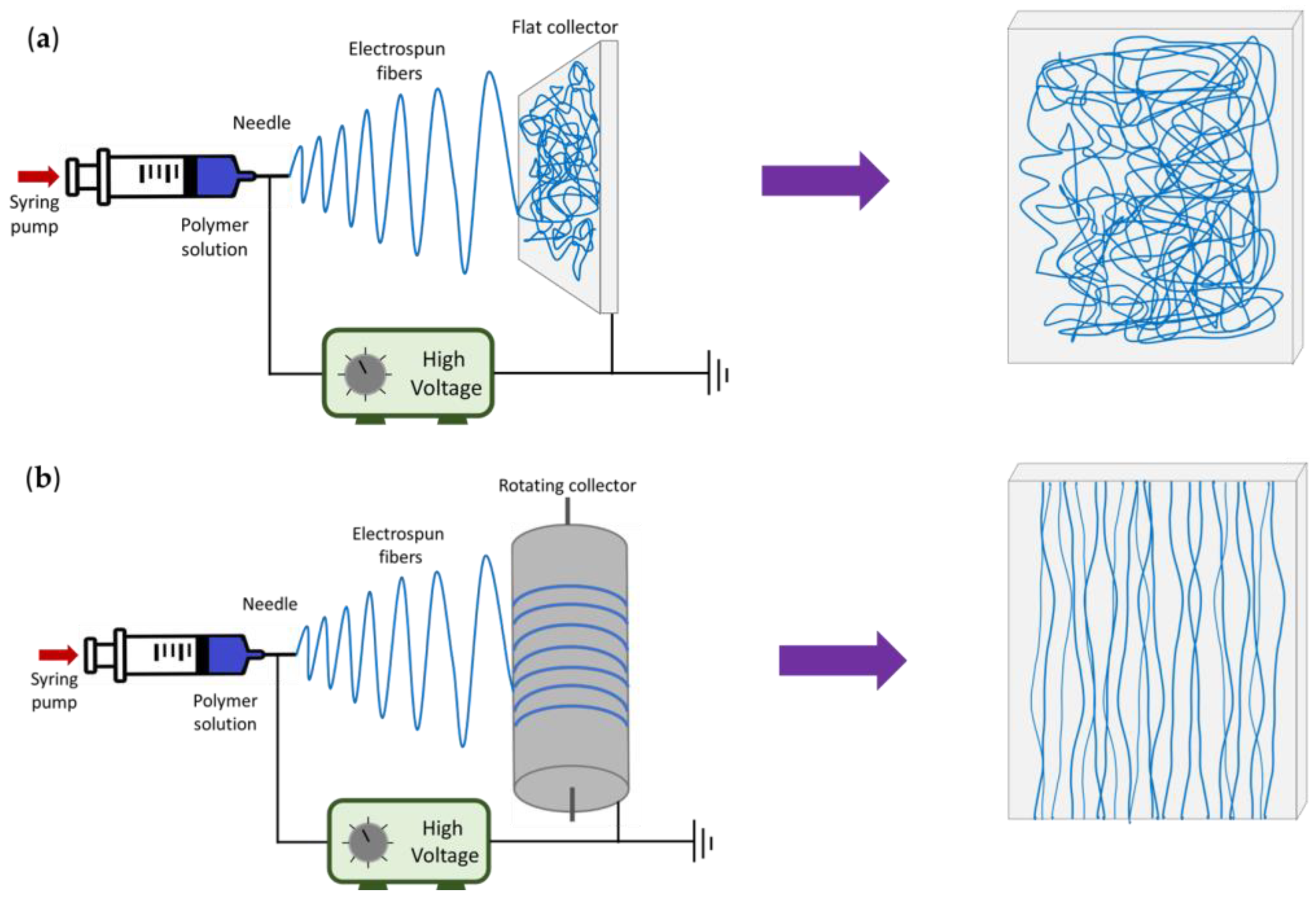


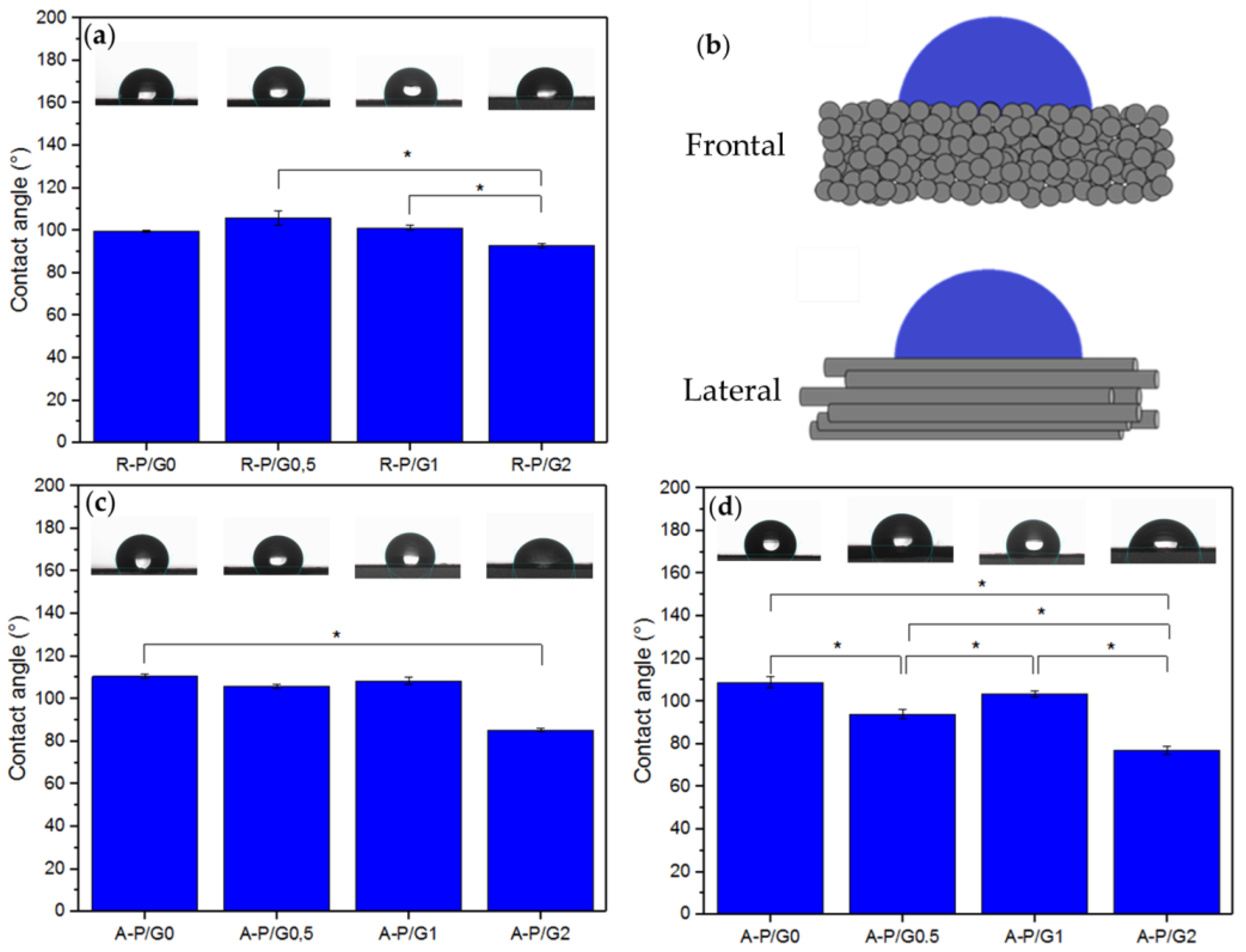
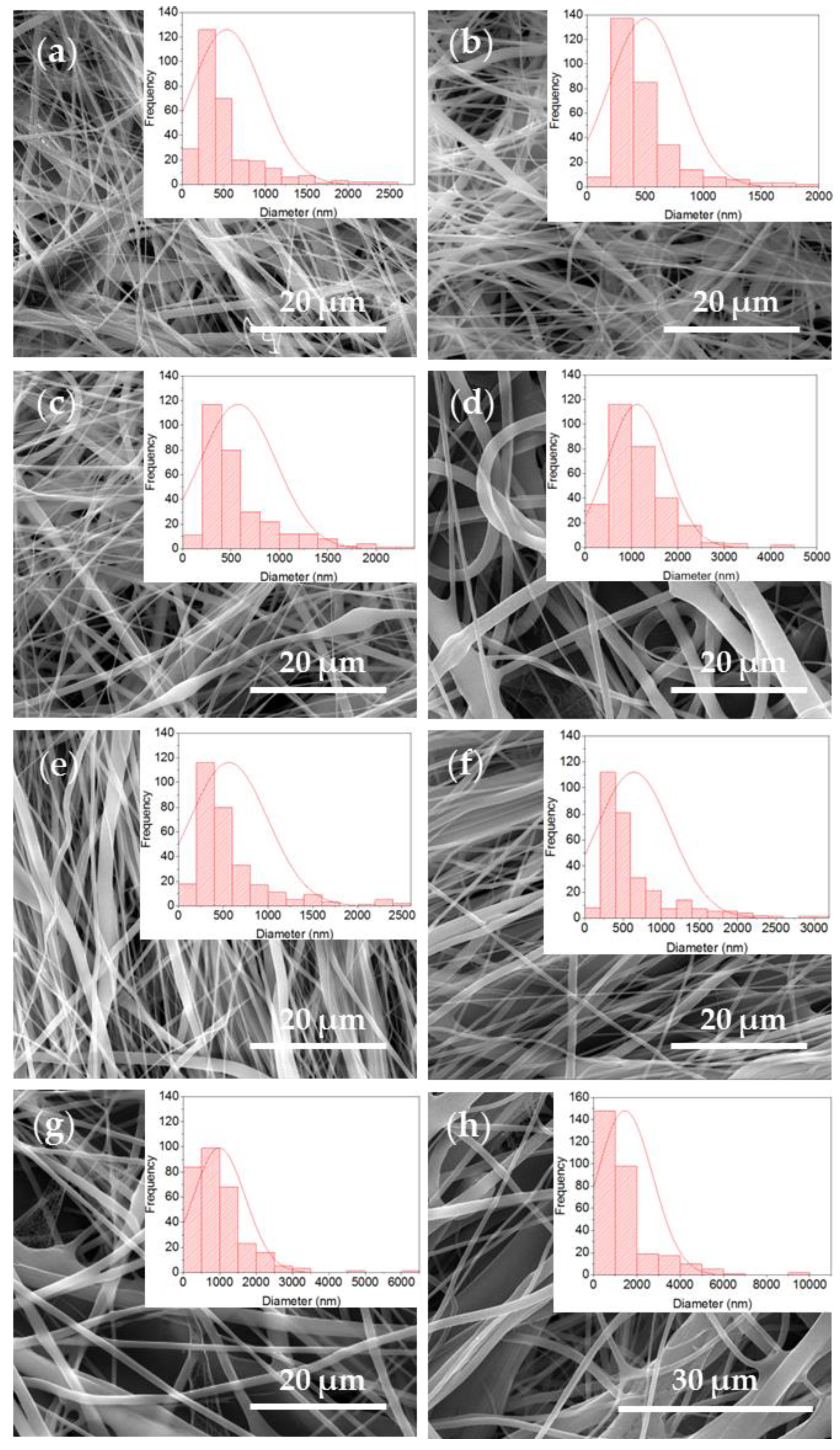
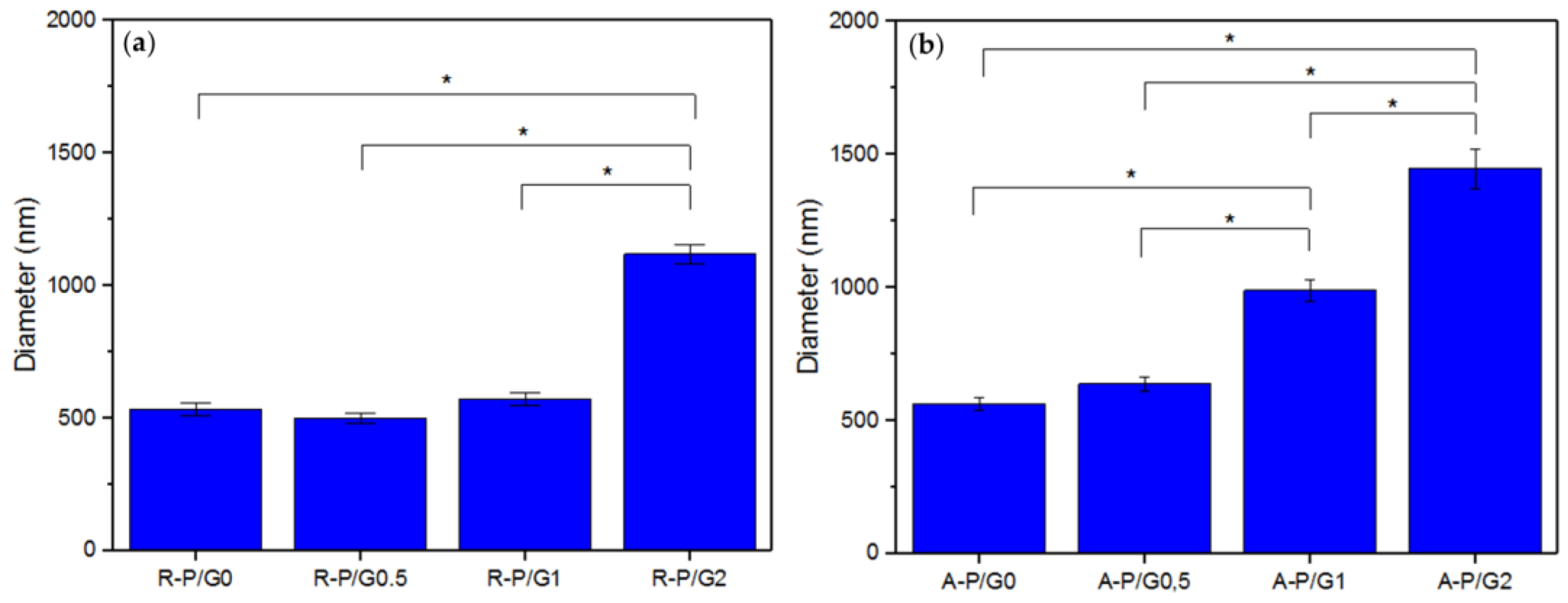
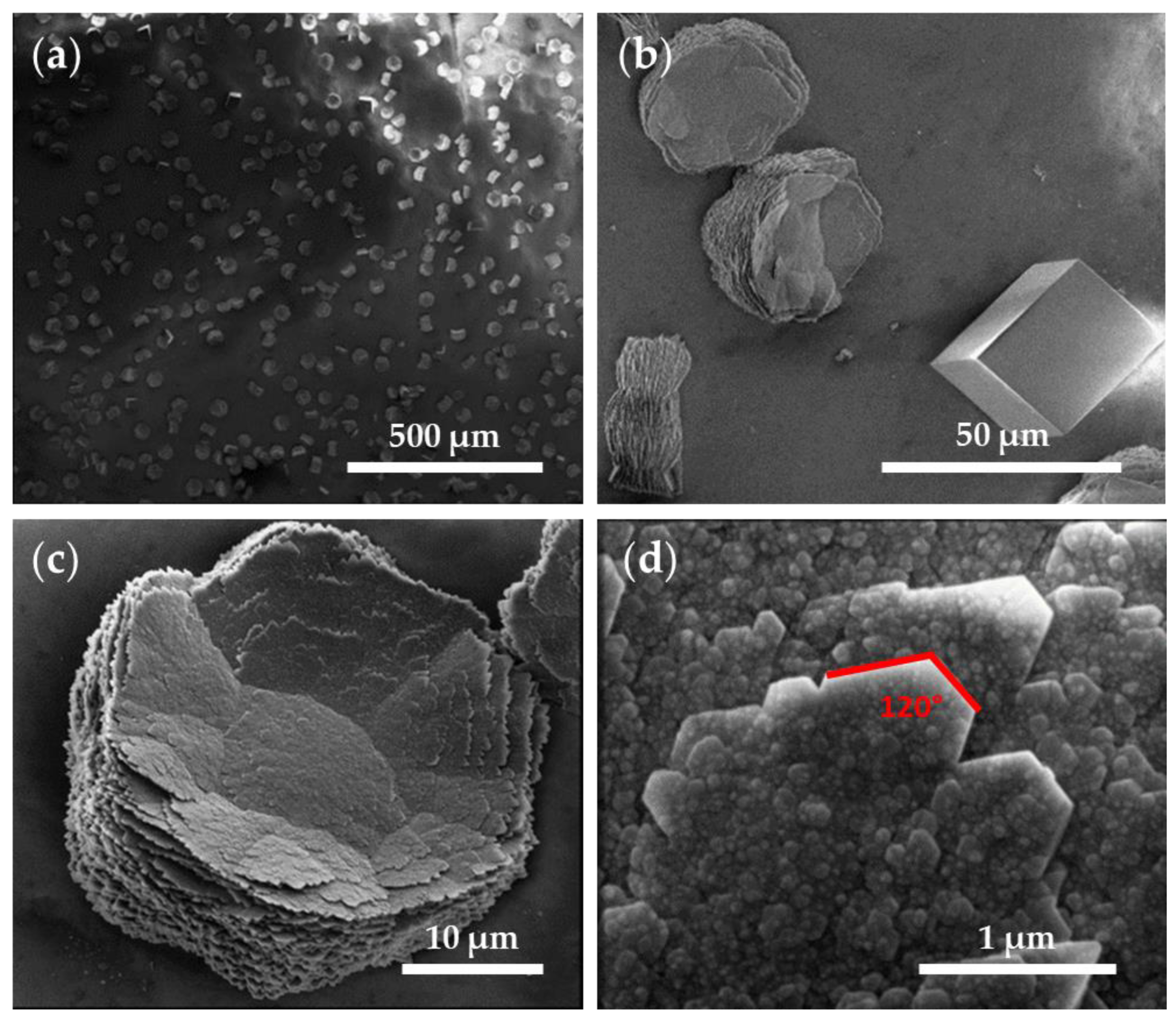
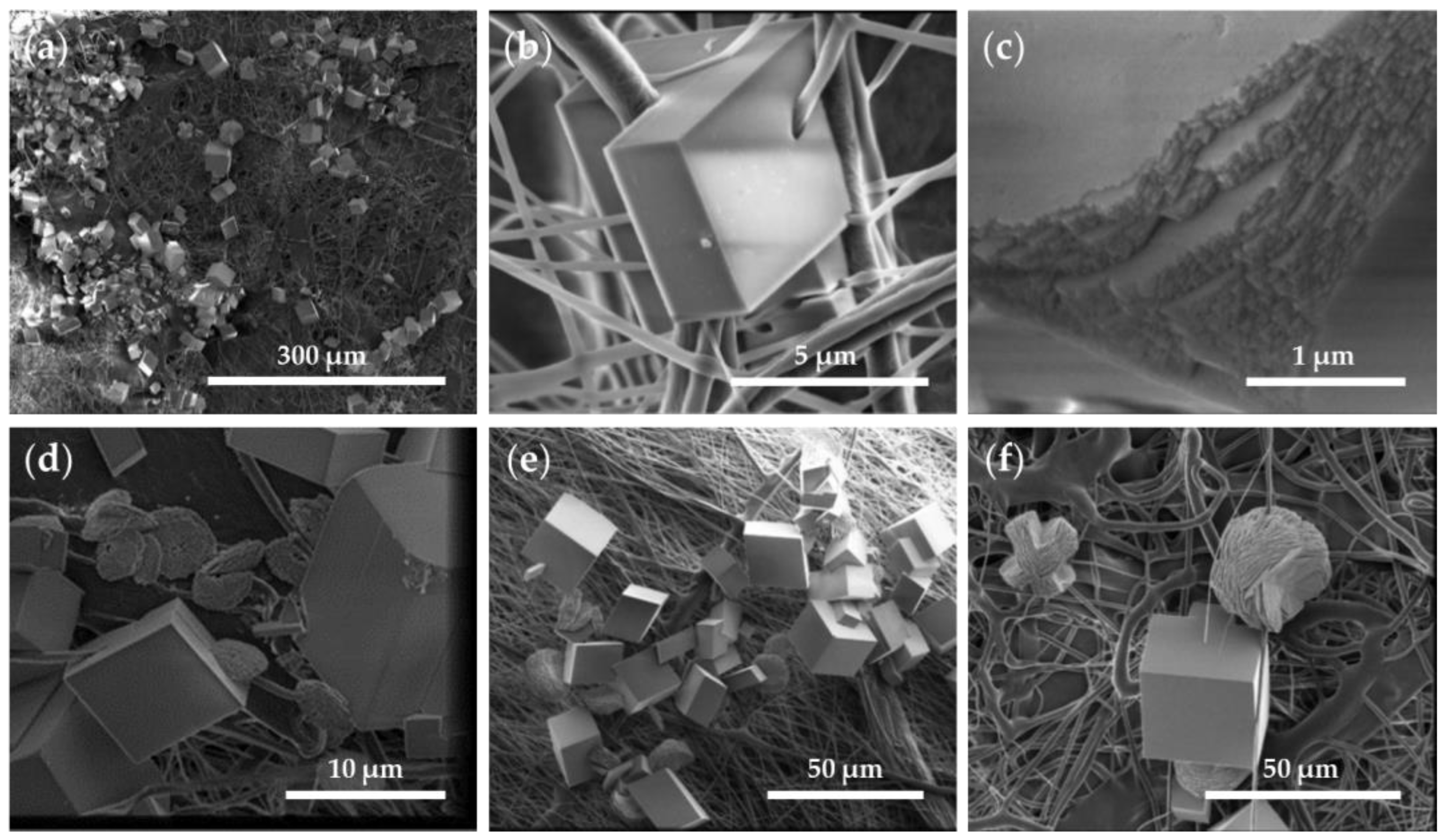
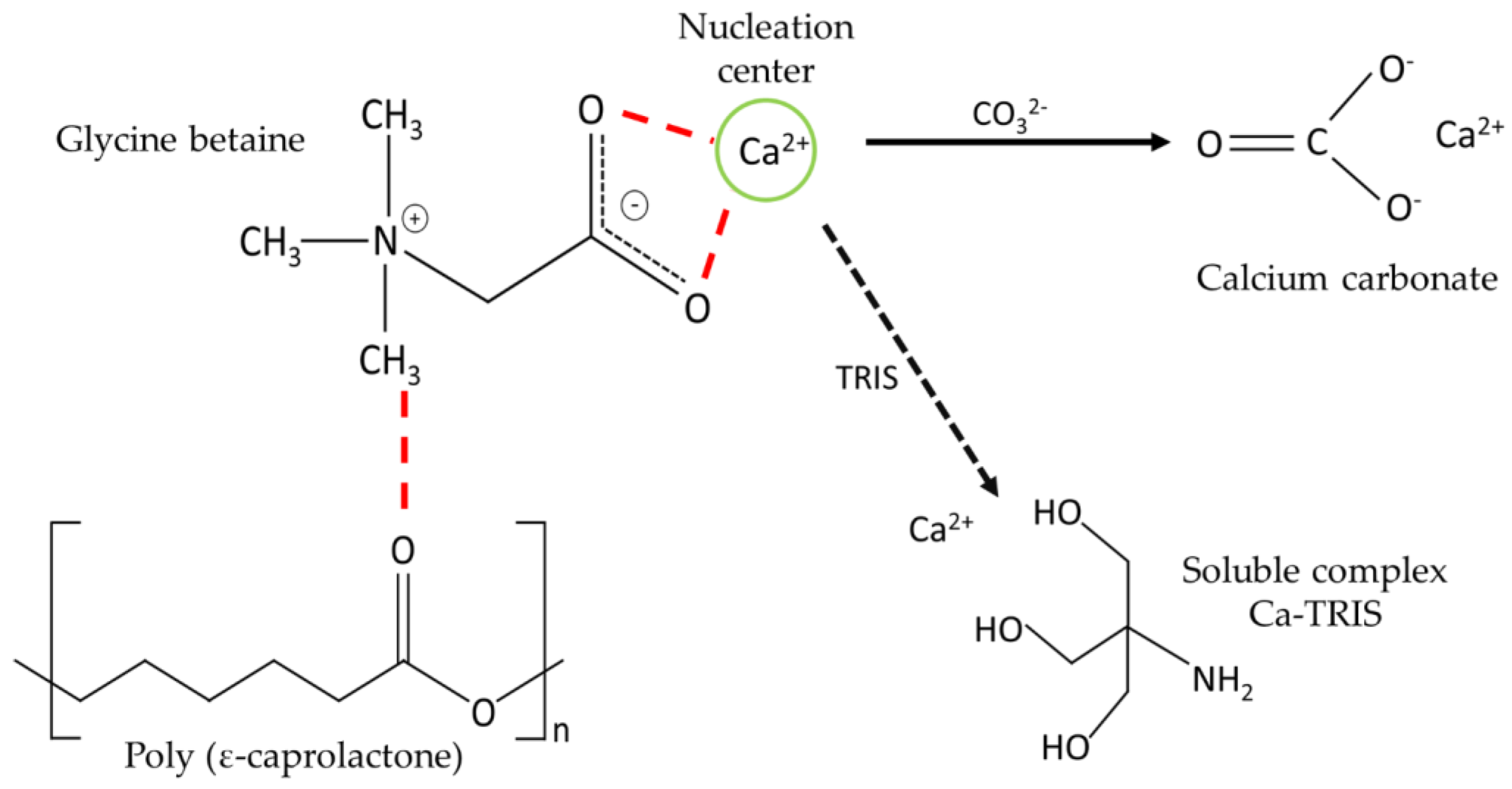
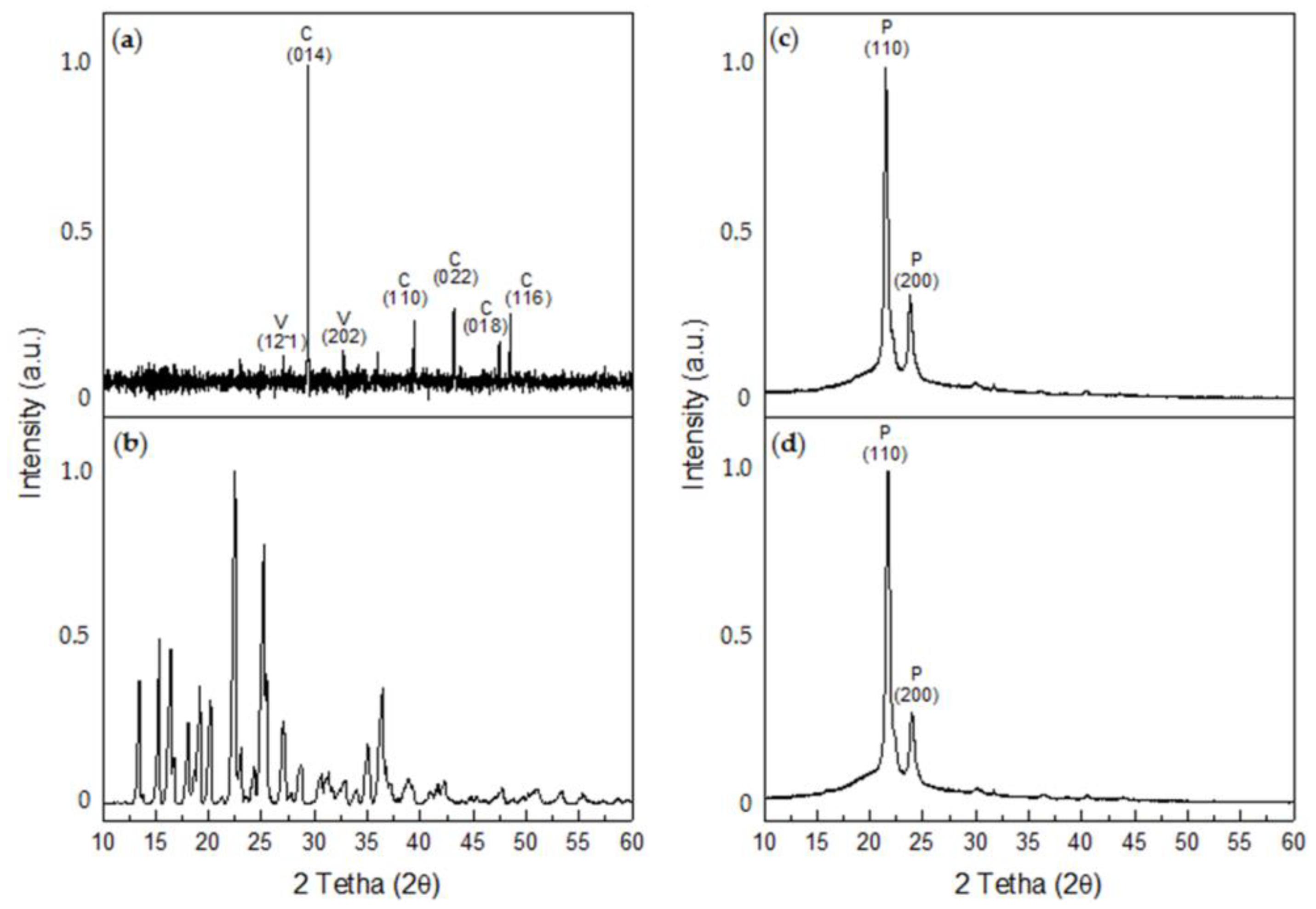

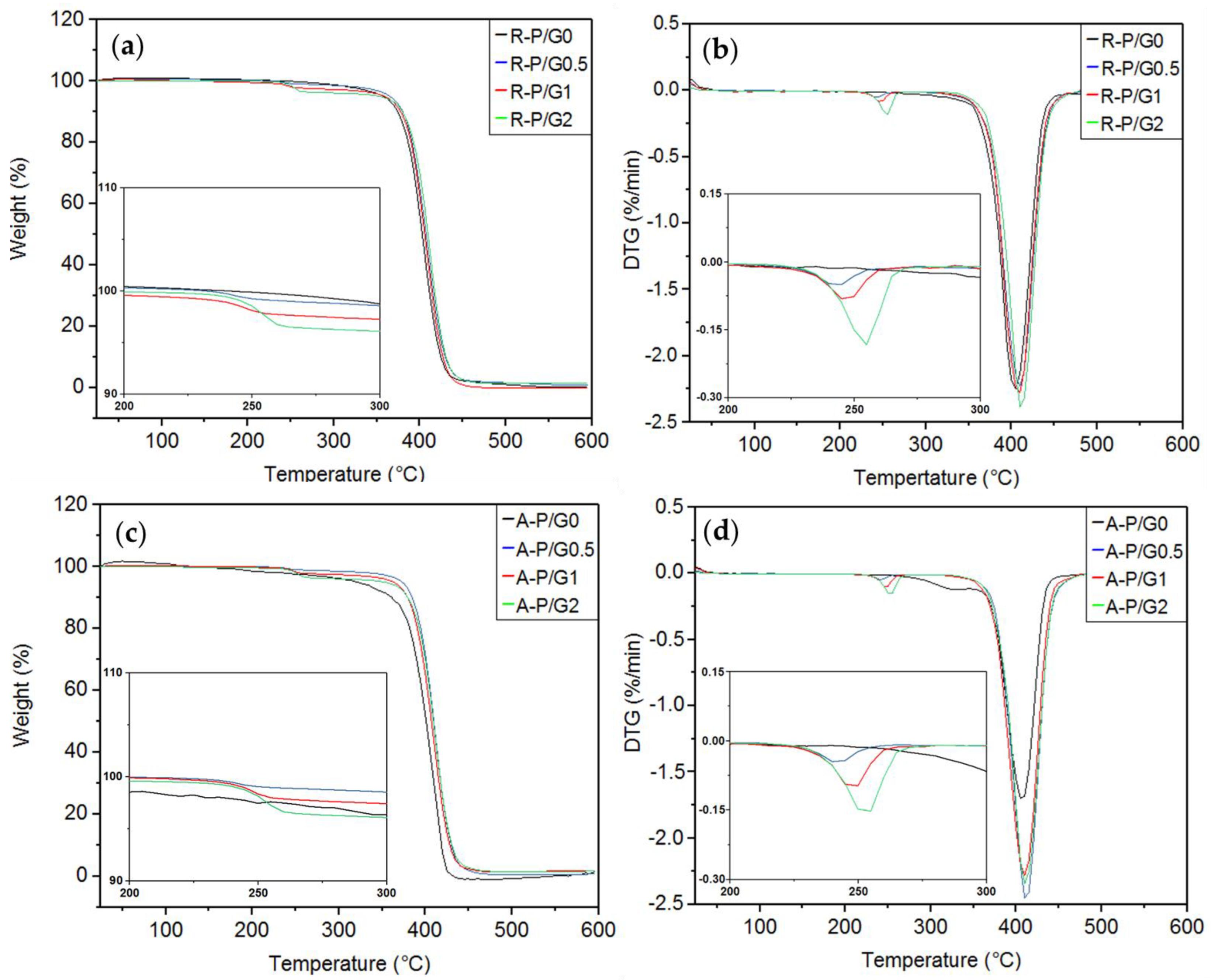

| Variables | R-P/G0-EPnF | R-P/G0.5-EPnF | R-P/G1-EPnF | R-P/G2-EPnF | A-P/G0-EPnF | A-P/G0.5-EPnF | A-P/G1-EPnF | A-P/G2-EPnF |
|---|---|---|---|---|---|---|---|---|
| Voltage (kV) | 16.5 | 18.5 | 17.5 | 18.5 | 16.5 | 17 | 17 | 18.5 |
| Feed rate (μL) | 3500 | 2500 | 2500 | 3000 | 3500 | 2500 | 2500 | 3000 |
| Distance (cm) | 20 | 20 | 20 | 20 | 20 | 20 | 20 | 20 |
| RPM | - | - | - | - | 2000 | 2000 | 2000 | 2000 |
| CaCO3 | R-P/G0-EPnF | R-P/G0.5-EPnF | R-P/G1-EPnF | R-P/G2-EPnF | A-P/G0-EPnF | A-P/G0.5-EPnF | A-P/G1-EPnF | A-P/G2-EPnF | |
|---|---|---|---|---|---|---|---|---|---|
| C | 29.6 ± 8.1 | 4.3 ± 2.1 | 13.1 ± 5.7 | 12.2 ± 4.7 | 15.8 ± 7.5 | 5.4 ± 1.9 | 8.2 ± 3.1 | 12.9 ± 5.2 | 16.2 ± 6.4 |
| V | 38 ± 4.8 | 0 | 15.3 ± 2.9 | 7.1 ± 1.9 | 11.4 ± 5.2 | 8.2 ± 1.4 | 0 | 7.3 ± 2.2 | 14.0 ± 2.6 |
| CaCO3 | R-P/G0-EPnF | R-P/G0.5-EPnF | R-P/G1-EPnF | R-P/G2-EPnF | A-P/G0-EPnF | A-P/G0.5-EPnF | A-P/G1-EPnF | A-P/G2-EPnF | |
|---|---|---|---|---|---|---|---|---|---|
| C | 228 | 229 | 169 | 219 | 144 | 268 | 116 | 206 | 124 |
| V | 89 | - | - | - | - | - | 89 | - | - |
| Sample | Calcite Unit Cell Volume (Å3) | Vaterite Unit Cell Volume (Å3) | Calcite (wt.%) Trigonal a = b ≠ c | Vaterite (wt.%) Hexagonal a = b ≠ c |
|---|---|---|---|---|
| CaCO3 | 368.3375 | 125.0272 | 67.072; a = 4.99; c = 17.07 | 32.928; a = 4.12; c = 8.47 |
| R-P/G0-EPnF | 361.3516 | 100; a = 4.95; c = 17.02 | ||
| R-P/G0.5-EPnF | 358.6144 | 100; a = 4.95; c = 16.9 | ||
| R-P/G1-EPnF | 368.6599 | 100; a = 4.99; c = 17.08 | ||
| R-P/G2-EPnF | 366.6264 | 100; a = 4.98; c = 17.01 | ||
| A-P/G0-EPnF | 366.3786 | 11.88; a = 4.98; c = 17.04 | ||
| A-P/G0.5-EPnF | 360.2547 | 124.5827 | 97.42; a = 4.95; c = 16.93 | 2.57; a = 4.13; c = 8.40 |
| A-P/G1-EPnF | 367.4933 | 100; a = 4.98; c = 17.05 | ||
| A-P/G2-EPnF | 363.9129 | 100; a = 4.96; c = 17.02 |
| 1st Thermal Decomposition Process | 2nd Thermal Decomposition Process | Total Mass Loss (%) | |||||
|---|---|---|---|---|---|---|---|
| Sample | Ti (°C) | Tf (°C) | Tmax (°C) | Ti (°C) | Tf (°C) | Tmax (°C) | |
| R-P/G0-EPnF | - | - | - | 249.0 | 454.0 | 405.5 | 96.4 |
| R-P/G0.5-EPnF | 214.5 | 259.1 | 241.8 | 299.8 | 484.1 | 409.7 | 99.3 |
| R-P/G1-EPnF | 214.8 | 268.8 | 248.7 | 298.8 | 484.9 | 410.0 | 99.8 |
| R-P/G2-EPnF | 214.9 | 279.4 | 255.1 | 299.8 | 484.7 | 411.3 | 98.5 |
| A-P/G0-EPnF | - | - | - | 247.8 | 464.4 | 407.3 | 98.9 |
| A-P/G0.5-EPnF | 214.8 | 264.3 | 244.0 | 295.3 | 477.0 | 411.9 | 99.3 |
| A-P/G1-EPnF | 214.2 | 269.1 | 247.7 | 295.9 | 477.4 | 410.2 | 98.1 |
| A-P/G2-EPnF | 214.7 | 276.5 | 253.9 | 301.0 | 477.1 | 410.9 | 98.3 |
| Thermal Decomposition Process | Total Mass Loss (%) | |||
|---|---|---|---|---|
| Sample | Ti (°C) | Tf (°C) | Tmax (°C) | |
| R-P/G0-EPnF | 238.4 | 440.3 | 402.7 | 93.3 |
| R-P/G0.5-EPnF | 241.4 | 443.4 | 407.3 | 95.9 |
| R-P/G1-EPnF | 241.0 | 444.4 | 405.8 | 93.0 |
| R-P/G2-EPnF | 284.9 | 446.8 | 409.2 | 93.9 |
| A-P/G0-EPnF | 280.0 | 430.9 | 398.8 | 94,0 |
| A-P/G0.5-EPnF | 265.9 | 431.5 | 408.0 | 95.3 |
| A-P/G1-EPnF | 279.9 | 431.9 | 405.8 | 90.9 |
| A-P/G2-EPnF | 274.7 | 419.9 | 409.6 | 96.0 |
Disclaimer/Publisher’s Note: The statements, opinions and data contained in all publications are solely those of the individual author(s) and contributor(s) and not of MDPI and/or the editor(s). MDPI and/or the editor(s) disclaim responsibility for any injury to people or property resulting from any ideas, methods, instructions or products referred to in the content. |
© 2023 by the authors. Licensee MDPI, Basel, Switzerland. This article is an open access article distributed under the terms and conditions of the Creative Commons Attribution (CC BY) license (https://creativecommons.org/licenses/by/4.0/).
Share and Cite
Butto-Miranda, N.; Cabrera-Barjas, G.; Ibáñez, A.; Neira-Carrillo, A. Preparation of Novel Electrospun Organic–Inorganic Hybrid Nanofibers Based on Polycaprolactone, Glycine Betaine, and Calcium Carbonate (P/G/CaCO3-EPnF). Crystals 2023, 13, 611. https://doi.org/10.3390/cryst13040611
Butto-Miranda N, Cabrera-Barjas G, Ibáñez A, Neira-Carrillo A. Preparation of Novel Electrospun Organic–Inorganic Hybrid Nanofibers Based on Polycaprolactone, Glycine Betaine, and Calcium Carbonate (P/G/CaCO3-EPnF). Crystals. 2023; 13(4):611. https://doi.org/10.3390/cryst13040611
Chicago/Turabian StyleButto-Miranda, Nicole, Gustavo Cabrera-Barjas, Andrés Ibáñez, and Andrónico Neira-Carrillo. 2023. "Preparation of Novel Electrospun Organic–Inorganic Hybrid Nanofibers Based on Polycaprolactone, Glycine Betaine, and Calcium Carbonate (P/G/CaCO3-EPnF)" Crystals 13, no. 4: 611. https://doi.org/10.3390/cryst13040611
APA StyleButto-Miranda, N., Cabrera-Barjas, G., Ibáñez, A., & Neira-Carrillo, A. (2023). Preparation of Novel Electrospun Organic–Inorganic Hybrid Nanofibers Based on Polycaprolactone, Glycine Betaine, and Calcium Carbonate (P/G/CaCO3-EPnF). Crystals, 13(4), 611. https://doi.org/10.3390/cryst13040611









